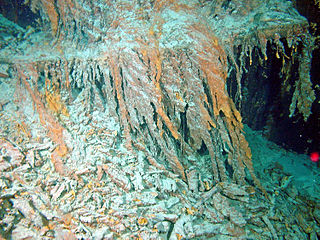
Halomonadaceae is a family of halophilic Pseudomonadota.

Ectoine is a natural compound found in several species of bacteria. It is a compatible solute which serves as a protective substance by acting as an osmolyte and thus helps organisms survive extreme osmotic stress. Ectoine is found in high concentrations in halophilic microorganisms and confers resistance towards salt and temperature stress. Ectoine was first identified in the microorganism Ectothiorhodospira halochloris, but has since been found in a wide range of Gram-negative and Gram-positive bacteria. Other species of bacteria in which ectoine was found include:
Halomonas is a genus of halophilic (salt-tolerating) bacteria. It grows over the range of 5 to 25% NaCl.

GFAJ-1 is a strain of rod-shaped bacteria in the family Halomonadaceae. It is an extremophile that was isolated from the hypersaline and alkaline Mono Lake in eastern California by geobiologist Felisa Wolfe-Simon, a NASA research fellow in residence at the US Geological Survey. In a 2010 Science journal publication, the authors claimed that the microbe, when starved of phosphorus, is capable of substituting arsenic for a small percentage of its phosphorus to sustain its growth. Immediately after publication, other microbiologists and biochemists expressed doubt about this claim, which was robustly criticized in the scientific community. Subsequent independent studies published in 2012 found no detectable arsenate in the DNA of GFAJ-1, refuted the claim, and demonstrated that GFAJ-1 is simply an arsenate-resistant, phosphate-dependent organism.
Halomonas venusta is a Gram-negative halophilic Pseudomonadota, first described as Alcaligenes venustus and later reclassified as Halomonas venusta, along with other species when the genera Deleya, Halomonas, and Halovibrio and the species Paracoccus halodenitrificans were unified into a single genus, Halomonas, while the genus Zymobacter was placed in the family Halomonadaceae. The name stems from the Latin noun venusta which means "lovely" or "beautiful". It was originally isolated in marine water from Hawaii.
Halomonas nitroreducens is a Gram-negative halophilic Pseudomonadota, that is able to respire on nitrate and nitrite in anaerobiosis.

Halomonas titanicae is a gram-negative, halophilic species of bacteria which was isolated in 2010 from rusticles recovered from the wreck of the RMS Titanic. It has been estimated by Henrietta Mann, one of the researchers that first isolated it, that the action of microbes like Halomonas titanicae may bring about the total deterioration of the Titanic by 2030. While the bacteria have been identified as a potential danger to oil rigs and other man-made objects in the deep sea, they also have the potential to be used in bioremediation to accelerate the decomposition of shipwrecks littering the ocean floor.
Halomonas subglaciescola is a Gram-negative halophilic bacterium. It was first isolated from an Antarctic, hypersaline, meromictic lake, but has since been found in other environments, such as fermenting seafood. It has a largely oxidative mode of metabolism and it is motile through peritrichous flagellation. This species doesn't utilise glucose, and its type strain is ACAM 12.
Halomonas ventosae is a moderately halophilic, denitrifying, exopolysaccharide-producing bacterium. Its type strain is Al12T.
Halomonas organivorans is a halophile able to degrade aromatic compounds. It's considered a potentially useful bacteria for decontamination of polluted saline habitats. Its type strain is G-16.1T.
Halomonas desiderata is an alkaliphilic, halotolerant and denitrifying bacterium first isolated from a municipal sewage works.
Halomonas alimentaria is a bacterium first isolated from jeotgal, a traditional Korean fermented seafood, hence its name. It is Gram-negative, moderately halophilic, non-motile and coccus- or short rod-shaped, with type strain YKJ-16T.
Halomonas johnsoniae is a halophilic bacteria first isolated from the environment surrounding dialysis patients. It is closely related to H. magadiensis.
Halomonas hamiltonii is a halophilic bacteria first isolated from the environment surrounding dialysis patients. It is closely related to H. magadiensis.
Halomonas stevensii is a halophilic bacteria first isolated from dialysis patients and the environment surrounding them. Its genome has been sequenced.
Nocardiopsis alkaliphila is an alkaliphilic bacterium from the genus of Nocardiopsis which has been isolated from soil from Egypt. Nocardiopsis alkaliphila produces nocardiopyrone A, nocardiopyrone B and pyridinols.
Halomonas meridiana is a bacterial species discovered in 1990 in the hypersaline lakes of Vestfold Hills, Antarctica.
Halomonas elongata is considered the type species of the genus Halomonas. It is a chemoorganotrophic, halophilic bacterium first isolated from a solar salt facility located in Bonaire, Netherlands Antilles.
Kushneria avicenniae is a Gram-negative and moderately halophilic bacterium from the genus of Kushneria which has been isolated from surface of leaves from the mangrove Avicennia germinans.
Chromohalobacter canadensis is a halotolerant bacterium from the genus of Chromohalobacter.



